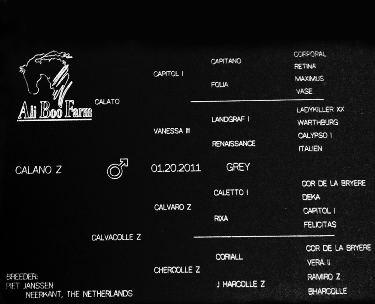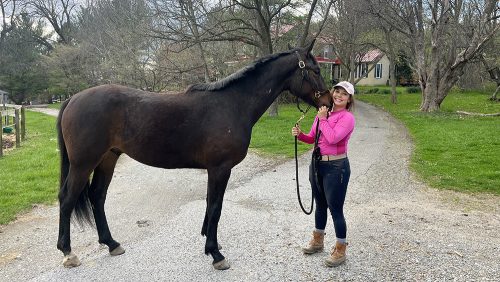Consumer Social Responsibility, or CSR as it is known, is something I’ve thought a lot about. What it means is that as consumers we have a responsibility toward society to be responsible in our purchases.
Corporations are not the only ones that have a responsibility towards society. We, as consumers, need to buy from ethical, socially responsible companies, and we need to know what we are buying. We need to know the background of the product; where it was made, who made it, and its “history.”
Do we not have the same responsibility as riders? Should we not know where our horses came from, what they have been doing, and what their bloodlines are? Should we not want to support our country and the breeders within?
So many times, I have overheard or asked a rider what their horse’s bloodlines are, and they reply that they have no idea. Many times, they do not even care. This probably stems from an even larger problem that we have in the States though—many trainers don’t care, or the dealers are not completely on the up and up.
I once had a dealer acquaintance of mine say to me, “oh just give them a different passport and tell them the horse is younger. They will never know the horse is two years older than you say.” She had probably a hundred passports lying around because when she sold her horses she never sent their passport with them. She did not think it was a big deal though; she only cared about the talent of the horse and what it could be sold for.
My response was, “Oh my gosh, are you kidding?” That is lying and misrepresenting the horse. In addition, as a breeder myself I would never do that to the breeders that work so hard and are so passionate about their horses. They deserve to have the riders know where their horses came from, who bred them, and what their bloodlines are. That way, if a rider finds a horse they love, they can go back to the breeder to see what else they might have. It must start at the top though. How can we hope to educate the young riders in the United States if the trainers are uneducated themselves or do not educate their riders?
ADVERTISEMENT
I am not saying that every rider should be able to tell me the full pedigree of their horse four generations back, because trust me; I could not even do that on all my horses. There are those that can though and kudos to them. That is one of my life goals: to be as good as the breeding pedigree greats!
Our riders and owners though, should be able to know the basics of their horse’s bloodlines; who the sire and dam-sire are. It is part of being a horseman, and it will help them in their future equine endeavors.
When I talk to friends or riders in Europe, not only can they tell me their horse’s sire and dam, but also go two generations back. These people have been raised knowing bloodlines. Some people speak English or Spanish as a second language; people in Europe speak bloodlines as a second language. So, every day I am learning, and will continue to try to learn more from the most knowledgeable and passionate individuals who can rattle off bloodlines easily.
I once had a good friend of mine, an accomplished and up-and-coming grand prix rider, ask me if I had any Indoctros. He knows that he loves the Indoctro offspring and that he has had great success with them. He will not pass up a good horse no matter its bloodlines, but he will take closer looks at Indoctros.
Certain bloodlines throw common traits and every rider has their “type,” just as this friend of mine did. Furthermore, if you know your horse’s bloodlines it may give you an advantage in figuring them out. For example, most Darcos tend to mature a little slower and need time to be brought along properly. When they are rushed in their training they may never reach their full potential and become frazzled in the process.
The other aspect of this is that riders should know what their horses have been doing and the U.S. Equestrian Federation needs to help support this. This topic could be a book in length, but to keep it short we need to help the breeders here at home in the U.S.
ADVERTISEMENT
Jumpers come over from Europe all the time who have been doing the 1.50-meter there and didn’t pan out; they then step into the pre-green hunter ring here ready to start their hunter careers. Whereas horses bred here in the States that may have started in the jumpers but who are actually meant to be hunters have to stick to their “status.” If a horse bred here showed in the 1.15-meter jumpers as a 5-year-old, they then have to do the second years. Where is the fairness in that?
Then the CSR status, or lack thereof, comes into play. The name is just changed, the breeder forgotten, and the horse goes back down to the baby green. That is until someone figures it out and then the trainer who changed the name or the owner gets into trouble.
Shouldn’t the USEF support breeders over here instead of supporting horses being imported from Europe? If that is what we are going to allow imported horses to do, then the horses here should be given the same advantage.
We have outstanding horses that are being bred and produced here in the United States, but if we want to become the next “Europe,” or even better, we have to work together as a group. Not just the riders, but also the owners, the trainers, and the sponsors. If we want to grow the breeding industry here in North America, we have to educate the people involved in this sport, and they have to want to learn.
Chronicle blogger Taylor Flury rides out of her family’s AliBoo Farm in Minooka, Ill., and competes primarily in the jumpers. She also runs AliBoo’s breeding program. Flury’s top mount is the U.S.-bred Role Model (Roc USA—Darling Devil), who claimed U.S. Equestrian Federation Horse of the Year titles in 2011 and 2012 in the 5- and 6-Year-Old Jumper divisions. Their story includes brain surgeries and broken shoulders along with the blue ribbons.
Read all of Taylor’s blogs here.
Want to know more about Taylor and Role Model? Read the article that appeared in the March 19, 2012 issue of The Chronicle of the Horse.















